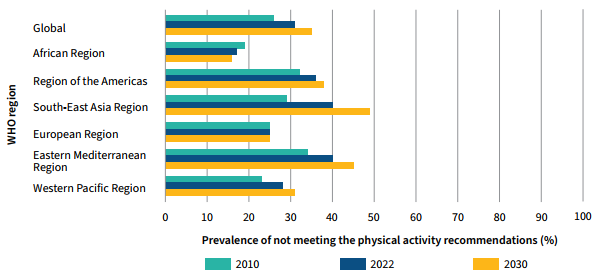
Introduction
Global physical inactivity is a pressing issue that threatens to derail the 2030 health targets. The Middle East and North Africa (MENA) region, in particular, faces unique challenges in addressing this problem. A recent report by World Health Organization (WHO) explores the current state of physical inactivity in MENA compared to the rest of the world and outlines key actions needed to reverse this trend. By understanding the challenges and implementing effective strategies, we can create a healthier, more active global population.
Health Issues Linked to Physical Inactivity
Physical inactivity significantly increases the risk of noncommunicable diseases (NCDs) such as heart disease, stroke, cancer, and diabetes. These conditions are leading causes of premature death globally and place a heavy burden on healthcare systems. In the MENA region, urbanisation and sedentary lifestyles have exacerbated obesity rates and related health issues. Globally, physical inactivity is responsible for approximately 3.2 million deaths annually, highlighting the need for urgent intervention. Beyond disease prevention, regular physical activity improves mental health and supports healthy ageing by maintaining mobility and independence. By prioritising physical activity, we can enhance public health outcomes and improve quality of life worldwide.
Physical Inactivity in MENA vs. Global Trends
Recent data highlights a worrying trend: global levels of physical inactivity remain high, with the MENA region experiencing some of the highest rates. In many MENA countries, cultural, environmental, and infrastructural factors contribute to these elevated levels. Compared to other regions, MENA shows a higher prevalence of inactivity, particularly among women. This disparity highlights the need for targeted interventions that consider regional specificities.
Globally, the prevalence of physical inactivity is rising, with a projected increase to 35% by 2030. In contrast, some regions, like the WHO African Region, are on track to meet the 2030 target. However, the MENA region lags behind, highlighting the need for urgent action.

Key Actions for Change in MENA
To address this issue, several key actions are recommended for the MENA region. Firstly, developing and implementing culturally sensitive policies across various sectors is crucial. Health, transport, urban planning, sports, and community services must work together to promote physical activity. These policies should enhance active transport options and create environments that encourage daily physical activity.
Secondly, aligning resources and vision is essential. Governments and stakeholders in MENA must ensure that policy commitments are supported by adequate resources. Monitoring progress and transparently reporting outcomes will help maintain accountability and drive change.
Focusing on Women and Older Adults in MENA
Persistent disparities in physical activity levels are concerning, particularly among women and older adults in MENA. Policies and programmes must focus on increasing participation in these groups. Addressing inequities in access to local opportunities for physical activity is vital. Overcoming barriers and shifting social norms can help increase participation among these populations.
The Role of Employers and Community Campaigns
Employers in MENA play a significant role in promoting physical activity. By implementing context-appropriate policies and programmes, they can foster regular physical activity among employees. Encouraging active workplaces benefits both employees and employers.
Community-wide communication campaigns are also crucial. These campaigns can shift societal and cultural norms, encouraging all adults to be active in enjoyable ways. By promoting the benefits of physical activity, these campaigns can inspire change at a grassroots level.
Conclusion
The path to achieving the 2030 target for physical activity is clear but challenging, especially in the MENA region. By prioritising effective policies and fostering collaboration across sectors, we can create a more active world. Governments, stakeholders, and communities in MENA and beyond must work together to overcome barriers and promote physical activity. With concerted effort, we can ensure that global physical inactivity is addressed, paving the way for a healthier future.
